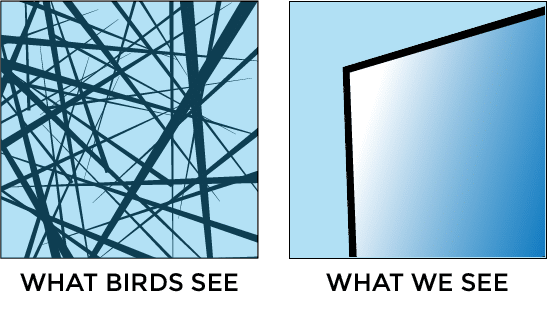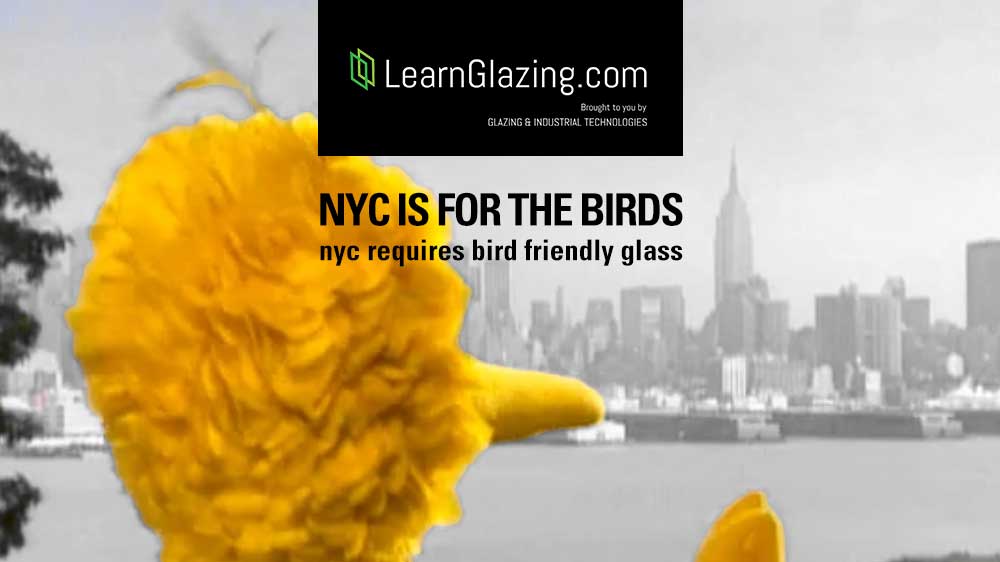New York is for the Birds: New York Requires Bird Friendly Glass
New York Requires All New Construction to be Bird-Friendly: Here’s what that means for glaziers
Some big news! New York City will have a major impact on the glazing industry in the city, and potentially all over the US if other cities follow New York’s lead.
The new legislation mandates the use of bird-friendly glass on new construction and major renovations. While some cities in California, such as San Francisco and Oakland, already have bird-friendly construction standards, New York is the largest city in the US to introduce bird-friendly construction rules. This could very well be the start of rolling changes across the country.
This is great news for birds. After all, up to a billion birds in the US die each year from glass collisions. Over the last several decades, the impact of buildings on bird populations has been severe: a recent study showed that there are nearly three billion fewer birds in North America today than in 1970, largely due to collisions with buildings.
Fortunately, there are many ways to design buildings to reduce bird fatalities. We’ll share some of these solutions in this article, and discuss the requirements of the new legislation.
Compliance Requirements
The New York City Council has approved a bill requiring new buildings and major renovations to meet construction standards that reduce the risk of bird collisions. The New York City Audubon has called the bill “the most broad-reaching bird-friendly building policy in the country.” While the bill has not yet been signed into law, Mayor Bill de Blasio is expected to do so.
The new rules are aimed at reducing bird collisions with glass. Why do birds tend to fly into glass? One reason is because they get confused by glass surfaces, which tend to reflect either their habitat or the sky. Unfortunately, birds often don’t recognize the danger and fly directly into windows.
The proposed bill (1482B) requires that 90 percent of the first 75 feet of all new building exteriors or major exterior renovations be made with materials that birds can clearly identify, such as glazed or patterned glass. The 75-foot cut-off is due to the fact that most collisions occur below the first 75 feet of a building.
The material cannot exceed a “threat factor” of 25, as determined by the American Bird Conservancy’s Bird Collision Deterrence Material Threat Factor Reference Standard. According to this standard, clear glass has a threat factor of 100. But this number can be brought down with a number of modifications.
Fortunately, many potential glass modifications are very practical. In fact, a lot of strategies for controlling building heat, light, and security are also bird-friendly.
Bird-Friendly Design Solutions
There are many ways to prevent bird collisions with buildings. But it’s important to note that these solutions are most cost-effective when incorporated into project designs from the outset.
Bird-friendly glass solutions can be divided into two categories: design choices and material choices or surface modifications. We’ll discuss design choices first.
Important bird-friendly design choices:
- Eliminate fly-through conditions: glass bridges, walkways, railings, free-standing elements, and perpendicular building corners are dangerous because birds can see right through them. Eliminating these features from your designs can drastically reduce collisions.
- Recessed windows, balconies, and awnings: recessed features create a visual cue for birds to avoid and reduce the amount of exposed visible glass; however, it does not completely eliminate the threat of collisions.
- Exterior screens, grilles, shutters, and sunshades: adding these unique architectural elements can provide clear visual cues for birds to avoid, without affecting the view for building occupants.
Once the important upfront design decisions have been made, it’s important to add visible markers to all remaining exposed glass. Making glass less reflective helps too, but is less effective than visible markers.
Glass surfaces can be modified with an image or pattern that is screened, printed, or applied to the surface. Ceramic fritted and acid-etched patterns are commonly used for such purposes, and have the added benefit of reducing light and heat transmission and increasing privacy. Other options include silk-screening and ultraviolet coatings.
It’s important to note that increasing the contrast and density of the pattern will improve its effectiveness. Below are some safe guidelines to follow:
- Use a pattern density of 10 cm by 10 cm or less
- Apply high-contrast visual markers that are at least 5 mm in diameter
- Use low reflectance glass
- Focus on the exterior surface of windows for maximum effectiveness

Next Steps
As mentioned before, we believe this legislation could be a sign of things to come for more cities across the country. Bird collisions are not just a New York issue, so be sure to keep an eye out for similar changes coming to your city. Now is a good time to understand these solutions so that you’re ready if/when bird-friendly design becomes a requirement for your customers.
Take a look at the resources below for more information about the new bill and a useful guide on bird-friendly design and glazing practices.
- Full details on the new requirements in the New York City bill are available here.
- Check out this free guide for more bird-friendly design ideas and best practices.

